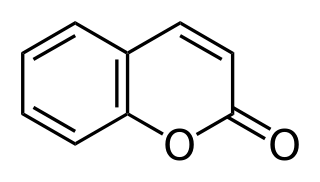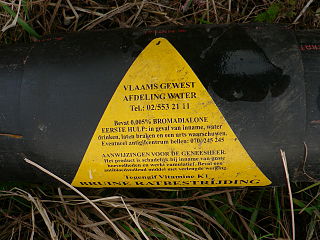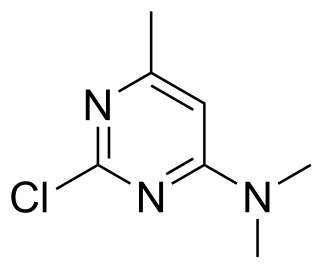A biocide is defined in the European legislation as a chemical substance or microorganism intended to destroy, deter, render harmless, or exert a controlling effect on any harmful organism. The US Environmental Protection Agency (EPA) uses a slightly different definition for biocides as "a diverse group of poisonous substances including preservatives, insecticides, disinfectants, and pesticides used for the control of organisms that are harmful to human or animal health or that cause damage to natural or manufactured products". When compared, the two definitions roughly imply the same, although the US EPA definition includes plant protection products and some veterinary medicines.

Warfarin, sold under the brand name Coumadin among others, is a medication that is used as an anticoagulant. It is commonly used to treat blood clots such as deep vein thrombosis and pulmonary embolism, and to prevent stroke in people who have atrial fibrillation, valvular heart disease or artificial heart valves. Less commonly it is used following ST-segment elevation myocardial infarction (STEMI) and orthopedic surgery. It is generally taken by mouth, but may also be used by injection into a vein.

Rodenticides are chemicals made and sold for the purpose of killing rodents. While commonly referred to as "rat poison", rodenticides are also used to kill mice, squirrels, woodchucks, chipmunks, porcupines, nutria, beavers, and voles.

Coumarin or 2H-chromen-2-one is an aromatic organic chemical compound with formula C
9H
6O
2. Its molecule can be described as a benzene molecule with two adjacent hydrogen atoms replaced by a lactone-like chain −(CH)=(CH)−(C=O)−O−, forming a second six-membered heterocycle that shares two carbons with the benzene ring. It can be placed in the benzopyrone chemical class and considered as a lactone.

Persistent organic pollutants (POPs), sometimes known as "forever chemicals" are organic compounds that are resistant to environmental degradation through chemical, biological, and photolytic processes. It is a toxic chemical that adversely affect human health and the environment around the world. Because they can be transported by wind and water, most POPs generated in one country can and do affect people and wildlife far from where they are used and released. The effect of POPs on human and environmental health was discussed, with intention to eliminate or severely restrict their production, by the international community at the Stockholm Convention on Persistent Organic Pollutants in 2001. The United States has taken strong domestic action to reduce emissions of POPs. For example, none of the original POPs pesticides listed in the Stockholm Convention is registered for sale and distribution in the United States today and in 1978, Congress prohibited the manufacture of PCBs and severely restricted the use of remaining PCB stocks. In addition, since 1987, EPA and the states have effectively reduced environmental releases of dioxins and furans to land, air, and water from U.S. sources.

Bromethalin is a neurotoxic rodenticide that damages the central nervous system.

Calcium phosphide (CP) is the inorganic compound with the formula Ca3P2. It is one of several phosphides of calcium, being described as the salt-like material composed of Ca2+ and P3−. Other, more exotic calcium phosphides have the formula CaP, CaP3, Ca2P2, and Ca5P8.

Coumatetralyl is an anticoagulant of the 4-hydroxycoumarin vitamin K antagonist type used as a rodenticide.

Zinc phosphide (Zn3P2) is an inorganic chemical compound. It is a grey solid, although commercial samples are often dark or even black. It is used as a rodenticide. Zn3P2 is a II-V semiconductor with a direct band gap of 1.5 eV and may have applications in photovoltaic cells. A second compound exists in the zinc-phosphorus system, zinc diphosphide (ZnP2).

Tetramethylenedisulfotetramine (TETS) is an organic compound that is used as a rodenticide. It is an odorless, tasteless white powder that is slightly soluble in water, DMSO and acetone, and insoluble in methanol and ethanol. TETS is a sulfamide derivative. It can be synthesized by reacting sulfamide with formaldehyde under acidic condition. When crystallized from acetone, it forms cubic crystals with a melting point of 255–260 °C.

Dicoumarol (INN) or dicumarol (USAN) is a naturally occurring anticoagulant drug that depletes stores of vitamin K. It is also used in biochemical experiments as an inhibitor of reductases.

4-Hydroxycoumarins belong to a class of vitamin K antagonist (VKA) anticoagulant drug molecules derived from coumarin by adding a hydroxy group at the 4 position to obtain 4-hydroxycoumarin, then adding a large aromatic substituent at the 3-position. The large 3-position substituent is required for anticoagulant activity.

Brodifacoum is a highly lethal 4-hydroxycoumarin vitamin K antagonist anticoagulant poison. In recent years, it has become one of the world's most widely used pesticides. It is typically used as a rodenticide, but is also used to control larger pests such as possum.

Bromadiolone is a potent anticoagulant rodenticide. It is a second-generation 4-hydroxycoumarin derivative and vitamin K antagonist, often called a "super-warfarin" for its added potency and tendency to accumulate in the liver of the poisoned organism. When first introduced to the UK market in 1980, it was effective against rodent populations that had become resistant to first generation anticoagulants.

Vitamin K antagonists (VKA) are a group of substances that reduce blood clotting by reducing the action of vitamin K. The term "vitamin K antagonist" is technically a misnomer, as the drugs do not directly antagonise the action of vitamin K in the pharmacological sense, but rather the recycling of vitamin K.

Chlorophacinone is an anticoagulant used as a rodenticide. It is classified as an extremely hazardous substance in the United States as defined in Section 302 of the U.S. Emergency Planning and Community Right-to-Know Act and is subject to strict reporting requirements by facilities which produce, store, or use it in significant quantities.

Crimidine is a convulsant poison used as a rodenticide. Crimidine was originally known by its product name, Castrix. It was originally produced in the 1940s by the conglomerate, IG Farben. It is classified as an extremely hazardous substance in the United States as defined in Section 302 of the U.S. Emergency Planning and Community Right-to-Know Act, and is subject to strict reporting requirements by facilities which produce, store, or use it in significant quantities. It is also no longer used in the United States as a rodenticide, but is still used to this day in other countries.

Carbophenothion also known as Stauffer R 1303 as for the manufacturer, Stauffer Chemical, is an organophosphorus chemical compound. It was used as a pesticide for citrus fruits under the name of Trithion. Carbophenothion was used as an insecticide and acaricide. Although not used anymore it is still a restricted use pesticide in the United States. The chemical is identified in the US as an extremely hazardous substance according to the Emergency Planning and Community Right-to-Know Act.

d-CON is an American brand of rodent control products owned and distributed in the United States by the UK-based consumer goods company Reckitt. The d-CON product line includes traps and baits for use around the home for trapping and killing rats and mice. As of 2015, bait products use first-generation vitamin K anticoagulants as poison.
1-(4-Chlorophenyl)silatrane is an extremely toxic organosilicon compound which was developed by M&T Chemicals as a single-dose rodenticide. It was never registered as rodenticide, except for experimental use. 1-(4-Chlorophenyl)silatrane was one of the chemicals studied in the Project Coast.


















